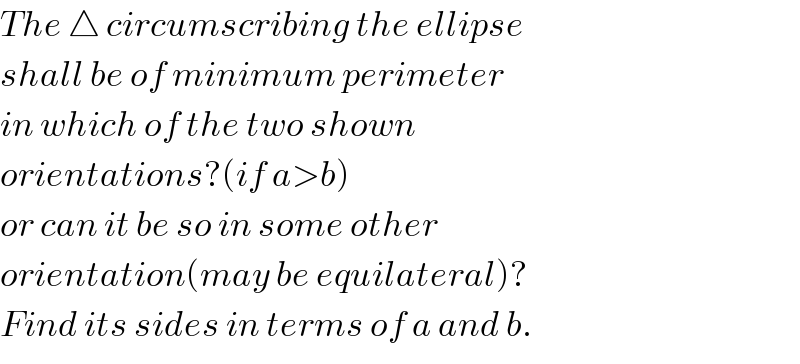
Question and Answers Forum
Question Number 52731 by ajfour last updated on 12/Jan/19

Commented by MJS last updated on 12/Jan/19
![for b=a (circle) the equilateral triangle is the one with minimum perimeter. we can draw an equilateral triangle for a circle with r=a and then compress with the factor (a/b) [P= ((x),(y) ) → P′= ((x),(((b/a)y)) )] A′= (((acos α)),((bsin α)) ) B′= (((acos (α+120°))),((bsin (α+120°))) ) C′= (((acos (α−120°))),((bsin (α−120°))) ) now calculate the perimeter p(α) and find its min/max p′(α)=0 sorry I have no time at the moment](Q52742.png)
Commented by ajfour last updated on 12/Jan/19

Commented by mr W last updated on 12/Jan/19

Commented by ajfour last updated on 12/Jan/19

Commented by ajfour last updated on 12/Jan/19

Commented by MJS last updated on 12/Jan/19

Commented by ajfour last updated on 12/Jan/19

Commented by MJS last updated on 12/Jan/19

Commented by ajfour last updated on 12/Jan/19

Commented by MJS last updated on 12/Jan/19

Commented by ajfour last updated on 26/Jan/19

Answered by mr W last updated on 12/Jan/19
)) (U/(2b))=f(t)=[1+(√(1+((μ/t))^2 ))](t+(√(1+t^2 ))) f′(t)=((2((μ/t))(−(μ/t^2 )))/(2(√(1+((μ/t))^2 ))))(t+(√(1+t^2 )))+[1+(√(1+((μ/t))^2 ))](1+((2t)/(2(√(1+t^2 )))))=0 (μ^2 /(t^3 (√(1+((μ/t))^2 ))))=[1+(√(1+((μ/t))^2 ))]((1/(√(1+t^2 )))) μ^2 (√(1+t^2 ))=t^3 [1+(μ^2 /t^2 )+(√(1+((μ/t))^2 ))] ⇒μ^2 ((√(1+t^2 ))−t)=t^2 (t+(√(μ^2 +t^2 ))) ⇒solve for t=t(μ)... example μ=(a/b)=2: ⇒t=0.8045⇒f(t)=7.6828⇒U=15.3656b with orientation 2: μ=(1/2) ⇒t=0.4022⇒f(t)=3.8414⇒U=7.6828a=15.3656b i.e. both orientations give the same miminum perimeter. RP=2b[1+(√(1+((μ/t))^2 ))]t=5.92b PQ=RQ=b[1+(√(1+((μ/t))^2 ))](√(1+t^2 ))=4.72b](Q52743.png)
Commented by ajfour last updated on 12/Jan/19

